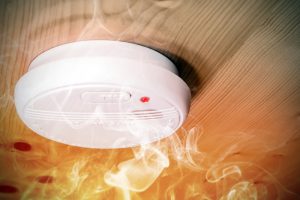 Of course, there’s never a bad time to test your carbon monoxide or smoke detectors. But as we edge closer to cooler temperatures, it is especially important to mention this, since soon enough you’ll be using your heating system on a regular basis. While heaters are not always the cause of house fires or CO exposure risk, they certainly can cause a home hazard if not properly maintained.
Of course, there’s never a bad time to test your carbon monoxide or smoke detectors. But as we edge closer to cooler temperatures, it is especially important to mention this, since soon enough you’ll be using your heating system on a regular basis. While heaters are not always the cause of house fires or CO exposure risk, they certainly can cause a home hazard if not properly maintained.
For instance, if an older furnace doesn’t receive routine maintenance, it may develop a cracked heat exchanger, which will allow harmful CO gas to escape into your living space where it can make you extremely ill, or worse. Heating maintenance is vital, and to supplement that we advise that you make sure your CO and smoke detectors are in good condition as well. If you need new detectors or have any questions at all, don’t hesitate to contact one of the professional electricians in Nashville, TN, on our team!
When and How to Test Your Smoke Detector
Most smoke detectors will give 3 chirps every minute to let you know that the batteries are dying. This is something that should never be ignored—even if you could ignore it! You may have your smoke detectors hardwired into your electrical system, which we do suggest, but replacing your backup batteries is still a good idea in the case of a power outage.
There are two main types of smoke detector testing—basic and crisis. Basic testing involves holding down the test button that is present on the smoke detector. When the button is held for a few seconds, the smoke detector will let out a shrill alarm, the same sound it would give off if you had a fire.
Crisis testing is something we don’t recommend doing on your own in case something were to go awry. However if you choose to go this route, the safest way to do so is by using a candle or some other self-contained material for burning, and holding it about 12-18 inches below the detector. Do not get it any closer—there is no need and you could accidentally damage the detector and hurt yourself.
Testing Your CO Detector
Similar to testing your smoke detector, you’re going to hold down the “test” button until you hear 2-3 beeps sound off. If this occurs then you know it is working as it should. There is no safe way to do a “crisis” test like we mentioned above for the smoke detector. If you are concerned that you are being exposed to high levels of carbon monoxide, then you should call in a pro for carbon monoxide testing.
Notes for Hardwired and Connected Detectors
If you have detectors that are hardwired and connected to your home security system, be sure to alert your home security company before going through with the alarm test, so they don’t send responders to your home. Additionally, it’s a good idea to have someone else in your home with you when doing the test so they can confirm that each detector that’s connected to the system is working throughout the house.
